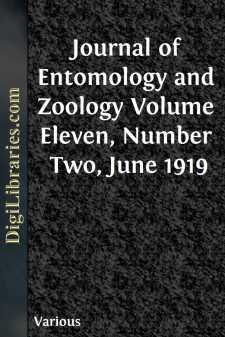Categories
- Antiques & Collectibles 13
- Architecture 36
- Art 48
- Bibles 22
- Biography & Autobiography 813
- Body, Mind & Spirit 142
- Business & Economics 28
- Children's Books 17
- Children's Fiction 14
- Computers 4
- Cooking 94
- Crafts & Hobbies 4
- Drama 346
- Education 46
- Family & Relationships 57
- Fiction 11829
- Games 19
- Gardening 17
- Health & Fitness 34
- History 1377
- House & Home 1
- Humor 147
- Juvenile Fiction 1873
- Juvenile Nonfiction 202
- Language Arts & Disciplines 88
- Law 16
- Literary Collections 686
- Literary Criticism 179
- Mathematics 13
- Medical 41
- Music 40
- Nature 179
- Non-Classifiable 1768
- Performing Arts 7
- Periodicals 1453
- Philosophy 64
- Photography 2
- Poetry 896
- Political Science 203
- Psychology 42
- Reference 154
- Religion 513
- Science 126
- Self-Help 84
- Social Science 81
- Sports & Recreation 34
- Study Aids 3
- Technology & Engineering 59
- Transportation 23
- Travel 463
- True Crime 29
Journal of Entomology and Zoology Volume Eleven, Number Two, June 1919
by: Various
Description:
Excerpt
ALMA EVANS
The animals were studied from serial sections cut in several planes. The stains used were carmine, hematoxylin and eosin. The hematoxylin seemed to show the tissues more clearly. A graphic reconstruction was attempted, but did not prove satisfactory because of the individual artificial foldings and contractions. The drawings were obtained by the use of a camera lucida. The general drawings, Figs.
– inclusive, are not filled in in great detail. The special drawings are shown at greater magnification with more of an attempt to show the actual condition.Dolichoglossus is a soft worm-like animal with ciliated surface. It is divided into three distinct regions: the proboscis, a long club-shaped organ; the collar, a fold in the surface just behind the proboscis, and the trunk, a long cylindrical portion posterior to the collar.
Dolichoglossus is a marine form living in sandy bays or sheltered places. Mucous glands in the surface epithelium secrete a sticky fluid which covers the body and to which tiny sand grains stick. The sand clinging to the mucous coated surface forms a fragile temporary tube in which the animal is usually secluded. The animals in the living condition are bright orange or red but lose their color very soon after preservation in alcohol or formalin.
The proboscis cavity extending the entire length of the organ is surrounded by a network of connective tissue supported by longitudinal bands of plain muscle. This cavity is supposed to communicate with the exterior by a very small opening, the proboscis pore, but this did not show in the specimens examined. The heart, proboscis gland and notochord are located in the posterior part of the proboscis.
The collar contains the central nervous system, part of the notochord, the dorsal blood vessel, ventral and dorsal mesenteries, mouth opening and anterior part of the alimentary canal.
The trunk contains the alimentary canal, dorsal and ventral blood vessels, dorsal and ventral nerves, the gill-slits, the reproductive bodies, dorsal and ventral mesenteries and muscle bands.
The nervous system consists of three parts: the central, located in the collar region, Fig. ; the sub-epidermic network extending over the entire body just under the surface epithelium, Figs. –; and the dorsal and ventral strands which are thickenings of the sub-epidermic network extending throughout the trunk, Figs. and . There is also quite a decided thickening of the sub-epidermic network at the base of the proboscis, Figs. , .
The vascular system consists of two parts, the central and the peripheral. The central is made up of the heart, a thin-walled vesicle at the base of the proboscis just dorsal to the notochord, and connected with it the proboscis gland, a plexus of capillaries just anterior to the notochord. Fig. . The peripheral system is composed of a ventral and a dorsal vessel. The dorsal starts at the heart and continues just ventral of the dorsal nerve throughout the length of the body. Figs....












